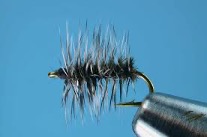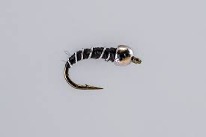
Our next Beginner’s Fly Tying session will be held at 7:00 PM on November 15th at Trinity United Methodist Church. The evening’s class will focus on two common fly patterns which reflect this time of the year (late fall/winter) when the diet of a fresh water fish changes. The abundance of caddisflies, mayflies, and terrestrials has waned and now the fish focus their attention to smaller food forms such as midges and other invertebrates which are prevalent through the winter. The two flies chosen for our November class are the zebra midge and the Griffith’s gnat (named for George Griffith, who first tied the fly).

While the zebra midge represents an immature midge in the pupa stage of its life cycle, the Griffith’s gnat represents a cluster of adult midges which have hatched, died, and collected together on the water surface.
Taking size into consideration for this beginner’s class, we will tie the zebra midge in a slightly larger hook (size 16) and the Griffith’s gnat in a size 12. This approach is generally recommended for anyone tying a new fly pattern: first achieve skill in tying the pattern on a larger hook — and then advance those skills to smaller hooks in the size range closer to which the “fly” exists in nature.
Consistent with our recent Beginner’s Fly Tying sessions, we will discuss midge entomology, materials used to tie midge patterns, and how to fish a midge imitation either as a single or multiple fly offering. As in the past, we welcome new fly tiers to these sessions.
Materials and instruction sheets are available to all who join us on November 15th and tying equipment is available for those who don’t already have their own tying vise and tools.
By Don Fine
You must be logged in to post a comment.